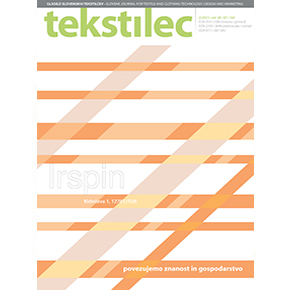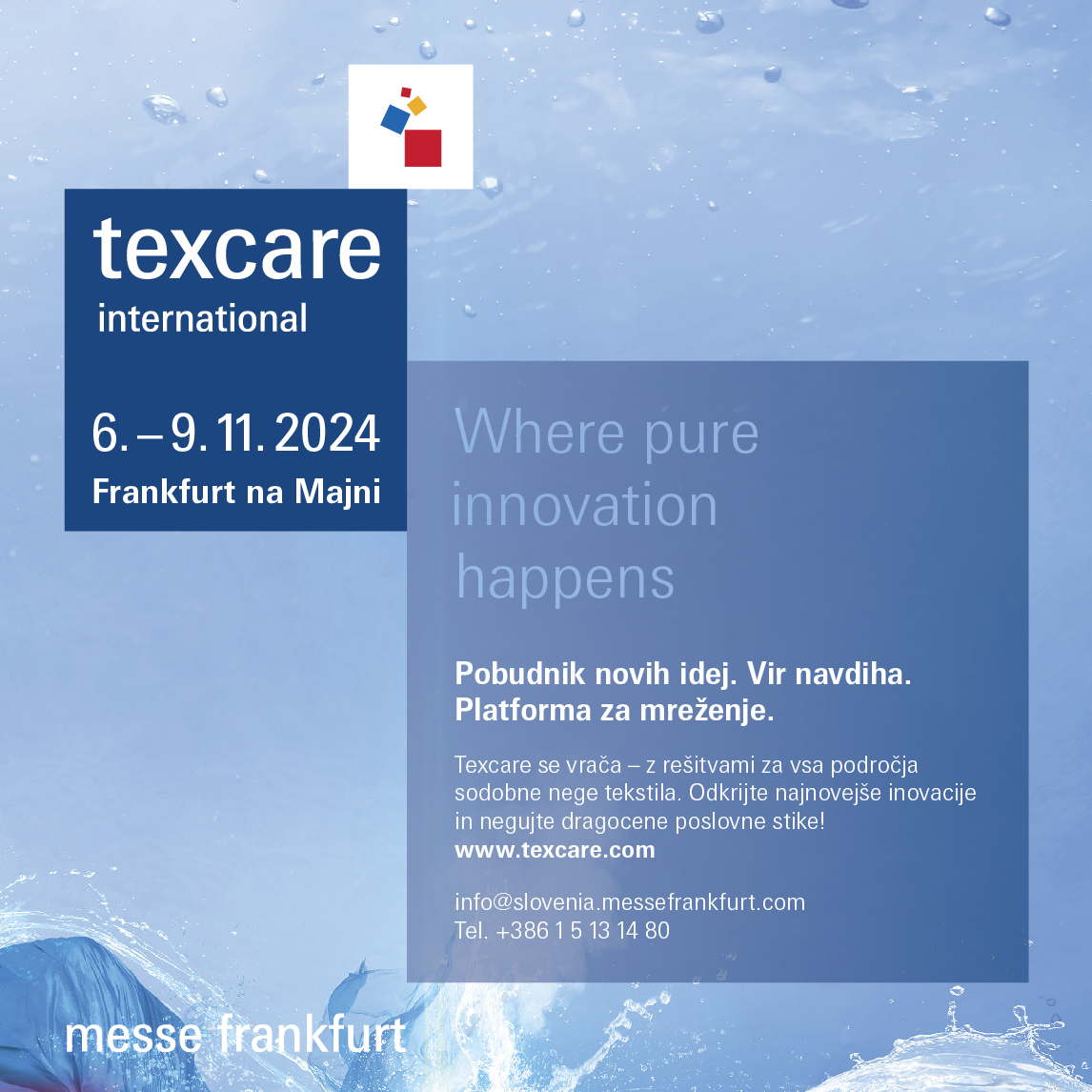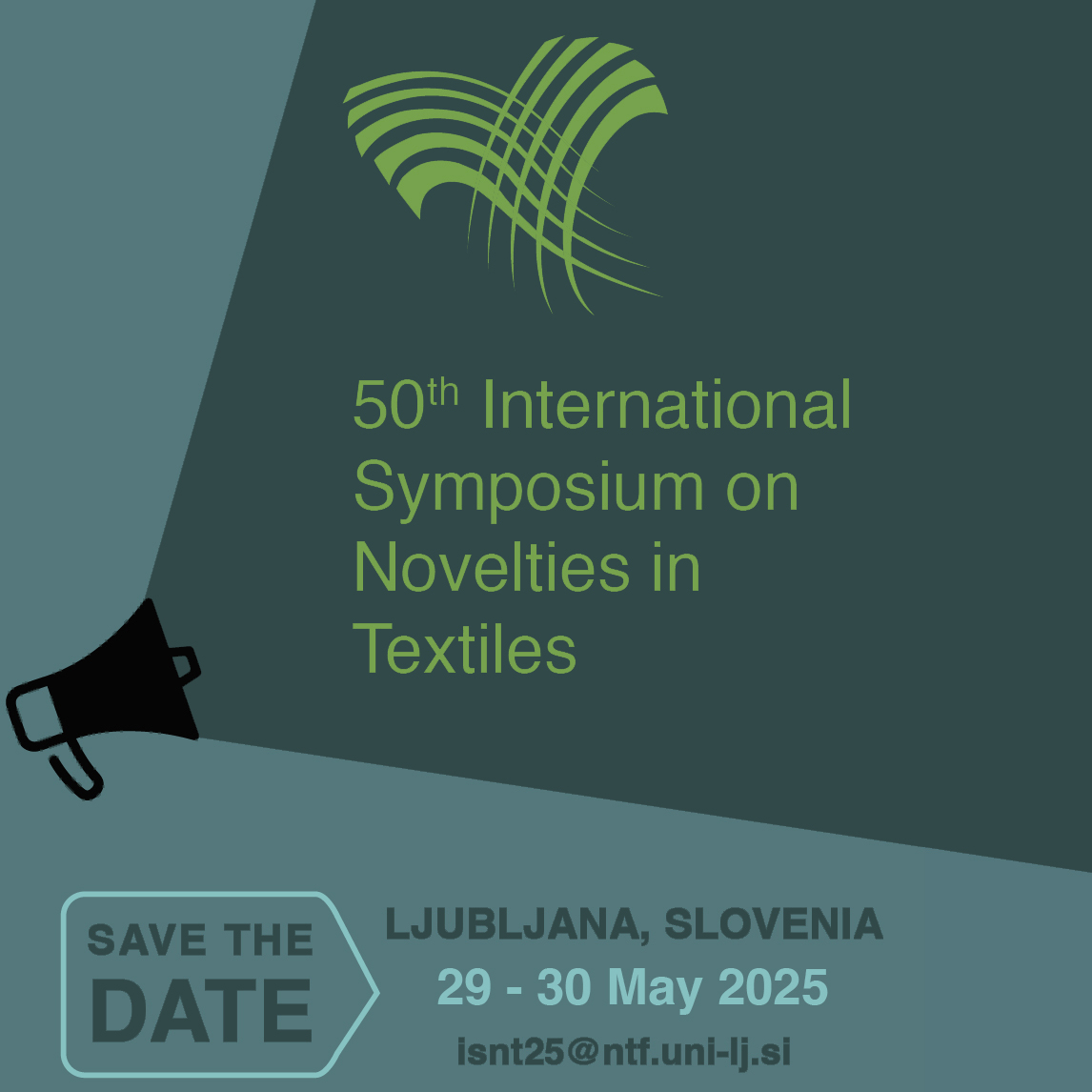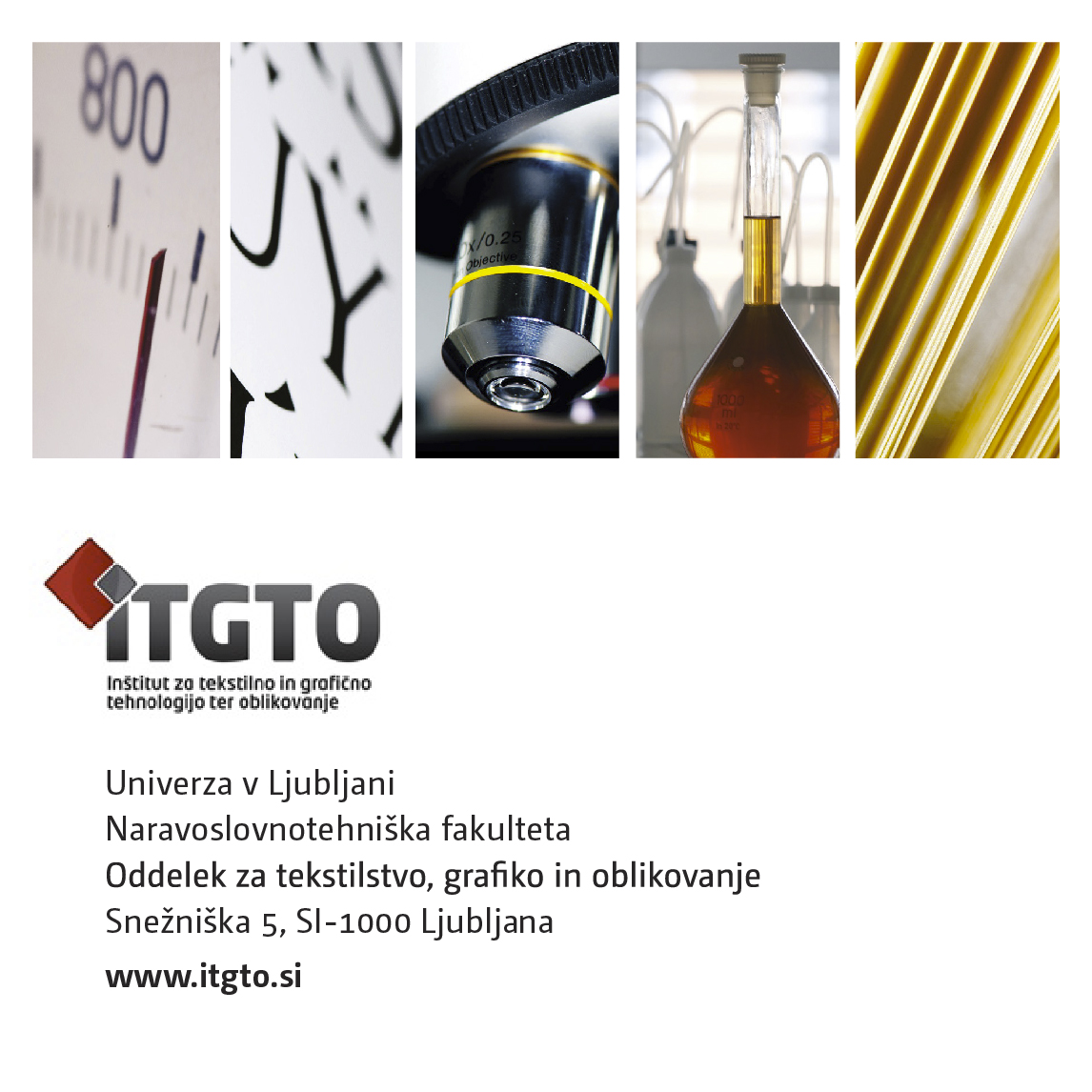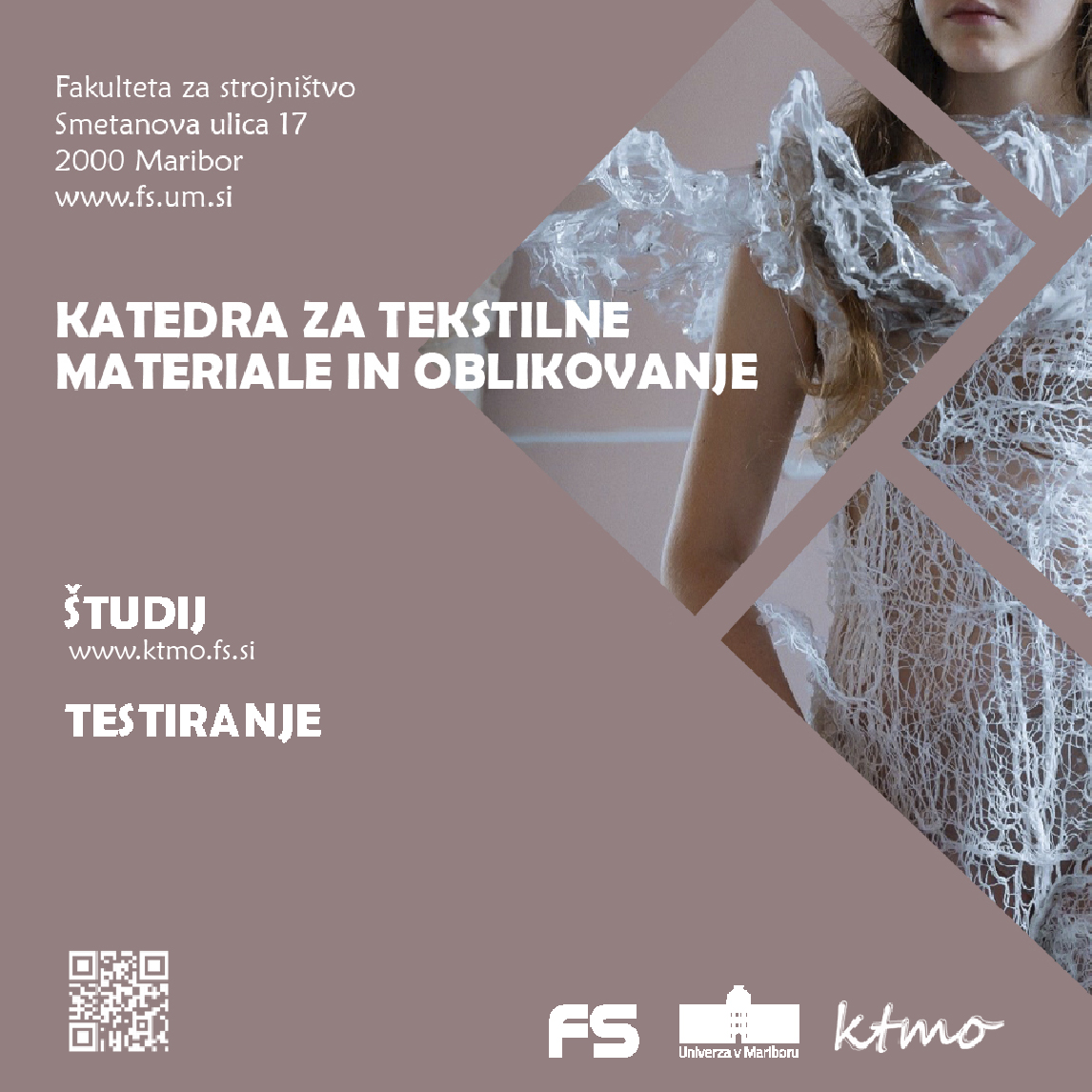Tekstilec, Vol. 58, 2015(2)
CONTENTS
SCIENTIFIC ARTICLES
100 Analyses of Colour Appearances on Different Display Devices
………..Dejana Javoršek, Janja Močnik, Marica Starešinič Abstract and References
University of Ljubljana, Faculty of Natural Sciences and Engineering, Department of Textiles, Snežniška ulica 5, SI-1000 Ljubljana
Original Scientific Article
Received 03-2015 • Accepted 04-2015
Corresponding author:
Assis. Prof. D.Sc. Dejana Javoršek
E-mail: dejana.javorsek@ntf.uni-lj.si
Abstract
Displaying desired colours on the screen via the web is still a crucial part of being successful for artists and photographers. The aim of our research was to compare accuracies and varieties of displayed colours on different devices and variations on the same device. Seven Apple display screens of various devices were analysed (iPad 2, iPad 3, iPad Mini, iPhone 4, iPhone 5, iMac and MacBook Pro) using two different browsers Safari and Chrome. For iMac display profile iMac, and for MacBook Pro display profile Colour LCD were used. The colour gamuts shown in CIE 1931 x, y and the CIELAB colour diagram were compared with the standard colour space sRGB. The results show that the appearances of colours on different devices are mostly dependent on screen quality. The appearances of colours are largely influenced by the choices of browsers for devices that support colour profiles. In regard to devices with included colour profiles within their displays, it is important to choose a browser that enables colour management to take into account the display colour profile. In our case, the Safari browser takes into account the specific display profile whilst Chrome does not consider those profile. However the results also depend on other factors. These results are important for graphics and fashion designers as well as textile technologists, who present their work and products to their potential clients on different devices.
Keywords: colour management, browser, display devices, colour spaces
References
- WONG, Alice. Colour Management for Web Browsers [online], Graphic Comunication, Senior project 2010, College of Liberal Arts, California Polytechnic State University, 2010, [accessed 28.5.2014]. Available on World Wide Web: <http://digitalcommons.calpoly.edu/grcsp/29/>.
- JAVORŠEK, Dejana, MUCK, Tadeja in KARLOVIĆ, Igor. Reproduciranje barv in barvno upravljanje. Ljubljana: Univerza v Ljubljani, Naravoslovnotehniška fakulteta, Oddelek za tekstilstvo, 2013, pp. 275.
- Smartphone Users Worldwide Will Total 1.75 Billion in 2014 [online], emarketer.com/Article/Smartphone-Users-Worldwide-Will-Total-175-Billion-2014 [accessed 16.2.2014]. Available on World Wide Web: <http://www.emarketer.com/Article/Smartphone-Users-Worldwide-Will-Total-175-Billion-2014/1010536>.
- SHANKAR, Venkatesh, VENKATESH, Alladi, HOFACKER, Charles and NAIK, Prasad. Mobile marketing in the retailing environment: current insights and future research avenues. Journal of interactive marketing, 2010, 24(2), 111–120, http://dx.doi.org/10.1016/j.intmar.2010.02.006.
- KERBS, W. Robert. An Empirical Comparison of User Color Preferences in Electronic Interface Design [online], California State Polytechnic University, 2003 [accessed 16.2.2014]. Available on World Wide Web: <http://www.hft.org/HFT03/paper03/05_Ker.pdf>.
- PRASAD, Shitala; KUMAR, Piyush; SINHA, Kumari Priyanka. Grayscale to Color Map Transformation for Efficient Image Analysis on Low Processing Devices. In: Advances in Intelligent Informatics. Editor: El-Sayed M. El-Alfy et al., Springer International Publishing Switzerland, 2015, 9–18, http://dx.doi.org/10.1007/978-3-319-11218-3_2.
- ICC Colour Management [online], International Colour Consortium [accessed 16.2.2014]. Available on World Wide Web: <http://www.colour.org/slidepres2003.pdf>.
- ZORIĆ, Vladimir and KARLOVIĆ, Igor. Color Reproduction on Tablet Devices, Acta Graphica, 2014, 25(1–2), 31-36.
- DUGGAN, Seán. Colour management: Use the correct ICC profile for web images [online]. [accessed 12.4.2014]. Available on World Wide Web: <http://www.seanduggan.com/technique/downloads/ICCprofiles_web_images.pdf>.
- LIPERA, Roger. Introduction to Colour & the Web [online]. Interactive Media Center, University at Albany [accessed 1.3.2015]. Available on World Wide Web: <http://library.albany.edu/imc/webcolor/color3_3.html>.
- PREISTER, Gary W. Htmlgoodies. Consistent Colors For Your Site – All You Need To Know About Web Safe Colors [online]. HTMLGoodies Staff [accessed 12.3.2014]. Available on World Wide Web: <http://www.htmlgoodies.com/tutorials/web_graphics/consistent-colors-for-your-site-all-you-need-to-know-about-web-safe-colors.html>.
- TINDEMANS, Simon. Web browser colour management [online]. Initial publication, 2012 [accessed 15.2.2013]. Available on World Wide Web: <http://simon.tindemans.eu/cm/webcm>.
- PILI, Fábio. Web browser colour management guide [online]. Published by Fábio Pili, 2010 [accessed 1.3.2015]. Available on World Wide Web: <http://cameratico.com/guides/web-browser-color-management-guide>.
- Colour Management in Safari [online]. Technical Note TN2220, Safari Developer Library [accessed 1.3.2015]. Available on World Wide Web: <https://developer.apple.com/library/safari/technotes/tn2220/_index.html>.
108 Skewnes and Spirality of Knitted Structures
………..Alenka Pavko-Čuden Abstract and References
University of Ljubljana, Faculty of Natural Sciences and Engineering, Department of Textiles, Snežniška ulica 5, SI-1000 Ljubljana
Scientific Review
Received 04-2014 • Accepted 05-2015
Corresponding author:
Assoc. Prof. D.Sc. Alenka Pavko Čuden
Tel.: +386 1 200 32 16
E-mail: alenka.cuden@ntf.uni-lj.si
Abstract
Weft knitted structures are affected by various forms of dimensional distortion. Inclination and distortion of loops within knitted structures are commonly known as skewness and spirality, respectfuly. Causes of skewness and spirality have been thoroughly investigated, analyzed and classified. They can basically be divided into two groups: material causes and process causes. One of the material causes is yarn related and is caused by residual torque in the yarn shown by its twist-liveliness. One of the more important process causes is machine related and is connected to knitting with multiple feeders on the circular knitting machine. Skewness and spirality have been subjects of research for almost a century. Models have been developed for understanding and predicting the loop distortion phenomena. Procedures for reduction or even elimination of the skewness/spirality have continuously been developed and improved. Some of them include changes in raw material, the others in mechanical processes and/or equipment while the other again concentrate on after-treatments. Many standards and other testing methods for measuring the skewness and spirality have been used in research and industrial practice. The uses of many terms describing this phenomenon have shown the continuous importance of the skewness/spirality problem on the one hand and the inconsistency of the terminology on the other.
Keywords: knitting, knitted fabric, skewness, spirality, loop inclination, yarn liveliness, residual torque
References
- CEKEN, Fatma. The effect of spirality of single jersey circular knit fabrics on seam distortions. Tekstil, 2010, 59(5), 186–192.
- KURBAK, Arif, KAYACAN, Özlem. Basic studies for modeling complex weft knitted fabric structures. Part II: A geometrical model for plain knitted fabric spirality. Textile Research Journal, 2008, 78(4), 279–288, http://dx.doi.org/10.1177/0040517507082351.
- BRACKENBURRY, Terry. Knitted Clothing Technology. Oxford: Wiley-Blackwell, 1992, 49–50.
- Textiles – determination of spirality after laundering. Percentage of wale spirality change in knitted garments. Part 1. ISO 1332:2005. 4p.
- Textiles – determination of spirality after laundering. Woven and knitted fabrics. Part 2. ISO 1332:2005. 21 p.
- Textiles – determination of spirality after laundering. Woven and knitted garments. Part 3. ISO 1332:2005. 8 p.
- Skewness change in fabric and garment twist resulting from automatic home laundering. AATCC Test method 179:2004. AATCC Technical Manual 2010, 311–314.
- Standard teminology relating to textiles. ASTM 123–92, 68 p.
- Standard test method for bow and skew in woven and knitted fabrics. ASTM D 3882:2012. 5p.
- SMIRFITT, John Arthur. An introduction to weft knitting. Watford: Merrow, 1975, 15–16.
- LAU, Y.M., TAO, X., DHINGRA, R.C. Spirality in single-jersey fabrics. Textile Asia, 1995, 8, 95–102.
- WITHERS, J.C. Textile terms and deenitions. Manchester: The Textile Institute, 8th Edition. 1986.
- PRIMENTAS, A. Spirality of weft knitted fabrics: Part I – Descriptive approach to the effect. Indian Journal of Fbre & Textile Research, 2003, 28, 55–59.
- KOTHARI, V. K. Spirality of cotton plain knitted farics with respect to variation in yarn and machine parameters. Indian Journal of Fibre & Textile Research, 2011, 36, 227–233.
- SHAHID, M.A., AHMED, F., MAHABUBUZZAMAN, A. K. M., HANNAN, M. A. and KHAN, A. N. Spirality in cotton knit fabrics before and after compacting using selected yarn count and stitch length. Journal of Innovation and Development Strategy, 2010, 4(2), 11–17.
- ABDEL-MEGIED, Z.M., AHMED, E.L.B. The effect of machine setting on weftknitted fabric properties. Journal of Applied Sciences Research, 2008, 4(11), 1371–1379.
- Knit fabrics and the reduction of torque. Technical bullletin, Cotton incorporated, Cary North Carlolina, 2002, 13 p.
- HASSAN, N. A. E. An investigation about spirality angle of cotton single jersey knitted fabrics made from conventional ring and compact spun yarn. Journal of American Science, 2013, 9(11), 402–416.
- DHINAKARAN, M. Bow, skewness and spirality in knitted fabrics. Textile Magazine, 2006, 47(7), 69.
- WOODS, H. J. The kinematics of twist. Journal of the Textile Institute, 1933, 24, T317–32.
- BACKER, S. The mechanics of bent yarns. Textile Research Journal, 1952, 22(10), 668–681.
- DAVIS, W., EDWARDS, C.H., Spirality in knitted fabrics. Journal of the Textile Institute, 1934, 25(3), T122–132.
- DAVIS, W., EDWARDS, C.H., Spirality in knitted fabrics: II Cotton. Journal of the Textile Institute, 1935, 26(3), T103–110.
- MUNDEN D. L., FlETCHER, M. W. A. Processing and properties of knitted stretch fabrics. General description of stretch yarns and fabrics. Journal of the Textile Institute Proceedings, 1956, 4(8), P638–P669.
- KLIMENT, L. Maschenverschiebung in Gestricken. Wirkerei und Strickerei Technik, 1977, 8, 394–397.
- TAO, J., DHINGRA R.C., CHAN, C.K., ABBAS, M.S. Effects of yarn and fabric construction of spirality of cottong single jersey farbic. Textile Reserach Journal, 1997, 67(1), 57–68.
- FATKIĆ, E., Spiralty of plain jerseys. Tekstil, 2005, 54(4), 153–159.
- BANERJEE, P.K., ALAIBAN, T.S. Geometry and dimensional properties of plain loops made of rotor spun cotton yarns. Part III: Spirality of the wale line. Textile Research Journal, 1988, 58(5), 287–290.
- CHEN, Q. H., AU, K. F., YUEN, C. W. M., YEUNG, K. W. Effects on yarn and knitting parameters on the spirality of plain knitted wool fabrics. Textile Research Journal, 2003, 73(5), 421–426, http://dx.doi.org/10.1177/004051750307300508.
- MARMARALI, A. B. Dimensional and physical properties of cotton/spandex single jersey fabrics. Textile Research Journal, 2003, 73(1), 11–14, http://dx.doi.org/10.1177/004051750307300102.
- DEGIRMENCI, Z., TOPALBEKIROGLU, M. Effects of weight, dyeing and the twist direction on the spirality of single jersey fabrics. Fibres & Textiles Eastern Europe, 2010, 18(3), 81–85.
- ZAMAN, M., WEBER, M. Efect of feeding speeds of elastomeric yarn with 100% cotton yarn on knit fabric spirality. In Proceedings of 46th Interantional Congress IFKT. Sinaia, 2012, 903–909.
- DESALE, V., RAICHURKAR, P.P., SHUKLA, A., YADAV, R. A. Study on spirality of single jersey knitted fabric. [online]. [accessed 14.5.2015]. Available on World Wide Web: <www.fibre2fashion.com>.
- De ARAUJO, M.D., SMITH, G.W. Spirality of knitted fabrics, Part 1: The nature of spirality. Textile Research Journal, 1989, 59(5), 247–256, http://dx.doi.org/10.1177/004051758905900501.
- De ARAUJO, M.D., The spirality of knitted fabrics. Tekstilec, 1990, 33(5), 157–167.
- HAIGH, J. Loop distortion in plain knitted fabrics. Wool Scientiec Rewiew, 1987, 64, 84–119.
- NUTTING, T.S. Spirality in weft knitted fabrics. Hosiery Research Bulletin, 1960, 4, 18–31.
- HEPWORTH, B. Spirality in knitted fabrics caused by twist-likely yarns: a theoretical investigation. Melliand Textilberichte, 1993, 74, 515–520 (E212–E213).
- HEPWORTH, B. Spirality in knitted fabrics caused by twist-likely yarns: a theoretical investigation. In Proceedings of the 34. Congress IFKT. Brno, 1992, 140–148.
- MURRELLS, C. M., TAO, X. M., XU, B. G., CHENG, K. P. S. An artificial neural network model for the prediction of spirality of fully relaxed single jersey fabrics. Textile Research Journal, 2009, 79(3), 227–234, http://dx.doi.org/10.1177/0040517508094091.
- CHOI, K.F., LO, T.Y. An energy model of plain knitted fabric. Textile Research Journal, 2003, 73(8), 739–748, http://dx.doi.org/10.1177/004051750307300813.
- CHOI, K.F., LO, T.Y. The shape and dimensions of plain knitted fabric: A fabric mechanical mode. Textile Research Journal, 2007, 76(1), 777–786, http://dx.doi.org/10.1177/0040517507069030.
- KURBAK, A. Plain knitted fabric dimensions. Part II. Textile Asia, 1998, April, 36–44.
- KURBAK, A., SOYDAN, A.S. Geometrical models for balanced rib knitted fabrics. Part III: 2 × 2, 3 × 3, 4 × 4, and 5 × 5 rib fabrics. Textile Research Journal, 2009, 79(7), 618–625, http://dx.doi.org/10.1177/0040517508096218.
- Spirality of plain knitted fabrics. Test method for the angle of spirality (in plain knitted garments). Woolmark test method TM 276, 2000.
- Standard test method for bow and skew in woven and knitted fabrics [online], [accessed 14.5.2015]. Available on World Wide Web: <http://www.astm.org/Standards/D3882.htm>.
- LY, N. G., DENBY, E. F., HOSCKE, B., N. A Quick test for measuring fabric Dimensional Stability. Textile Research Journal, 1988, 58(8), 463–468.
- PAVKO-ČUDEN, Alenka. Primerjava laboratorijskih preiskav in poskusnega nošenja pletenin različne surovinske sestave. Magistrsko delo, Ljubljana: Univerza v Ljubljani, Oddelek za tekstilstvo, 1993.
- PAVKO-ČUDEN, Alenka and MALEJ-KVEDER, Sonja. Primerjava poskusnega nošenja ter laboratorijskega preskušanja stabilnosti dimenzij in poševnosti pletenin (Comparison of wear trials and laboratory testing of knitwear dimensional stability and spirality). Tekstilec, 1994, 37(10), 293–300.
- CELIK, O., UCAR, N., ERTUHRUL, S. Determination of spirality in knitted fabrics by image analysis. Fibres & Textiles in Eastern Europe, 2005, 13(3), 47–49.
- SEMNANI, D., SHEIKHZADEH, M. New intelligent method of evaluating the regularity of weft-knitted fabrics by computer vision and grading development. Textile Research Journal, 2009, 79(17), 1578–1587, http://dx.doi.org/10.1177/ 0040517509104753.
- PRIMENTAS, A. Spirality of weft knitted fabrics: Part II – Methods fort the reduction of the effect. Indian Journal of Fbre & Textile Research, 2003, 28, 60–64.
- PRIMENTAS, A., IYPE C. Spirality of weft knitted fabrics: Part III – An innovative method fort the reduction of the effect. Indian Journal of Fbre & Textile Research, 2003, 28, 202–208.
- De ARAUJO, M.D., SMITH, G.W. Spirality of knitted fabrics. Part II: The effect of yarn spinning technology on spirality. Textile Research Journal, 1989, 59(6), 350–356, http://dx.doi.org/10.1177/004051758905900607.
- HIGGINS, L., ANAND, S. C., HALL, M. E., HOLMES D. A. Factors during tumble drying that infuence dimensional stability and distortion of cotton knitted fabrics. International Journal of Clothing Science and Technology, 2003, 15(2), 126–139, http://dx.doi.org/10.1108/09556220310470132.
- PARK, S.W., COLLIE, S., HERATH, C.N., KANG, B.C. and FUJIMOTO, T. Spirality related mechanical properties of single knit fabrics of linc LITE® and conventional yarns. Fibers and Polymers, 2008, 9(4), 467–475, http://dx.doi.org/10.1007/ s12221-008-0075-4.
- HOSSAIN, Md. Milon, JALIL, Mohamed Abdul, SAHA, Joykrishna, MIA, Md. Moznu, RAHMAN, Md. Mizanur. Impact of various yarn of different fiber composition on the dimensional properties of different structure of weft knitted fabric. International Journal of Textile and Fashion Technology, 2012, 2(1), 34–44.
- ASIF, A., RAHMAN, M., FARHA, F.I. Effect of knitted structure on the properties of knitted fabric. International Journal of Science and Research, 2015, 4(1), 1231–1235.
- MAVRUZ MEZARCIÖZ, Serin, OĞULATA, R. Tuğrul. The use of the Taguchi design of experiment method in optimizing spirality angle of single jersey fabrics. Tekstil ve Konfeksiyon, 2011, 21(4), 374–380.
121 The Influence of External Factors on Contact Colour Measurement of the Human Skin
………..Elizabeta Jevnikar, Dejana Javoršek, Sabina Bračko Abstract and References
University of Ljubljana, Faculty of Natural Sciences and Engineering, Department of Textiles, Snežniška ulica 5, SI-1000 Ljubljana
Original Scientific Article
Received 03-2014 • Accepted 05-2015
Corresponding author:
Assoc. Prof. D.Sc. Sabina Bračko
Tel.: +386 1 200 32 38
E-mail: sabina.bracko@ntf.uni-lj.si
Abstract
Human skin is a complex and unpredictable organ. Its colour can be objectively evaluated by using the colour measurement methods. The results of the measurements are affected by many factors, the impacts of which are not fully defined as yet. Certain factors directly determining the colour of the skin are dependent upon the individual and cannot be controlled. The emphasis of the research was on the second group of factors that refer to the measurement conditions and are variable and adaptable. The aim of the research was to examine the impact of the number of consecutive measurements, the selection of a body part, location of the selected area within a specific part of the body, the size of the measuring aperture, and the temperature on skin colour. The appropriateness of the instruments and repeatability of the results were also assessed, depending on the number of consecutive measurements and the selected size of the measuring aperture. The measurements were performed using two different reflectance spectrophotometers with the participation of a total of 6 volunteers. Within the measurements, the above-mentioned conditions were gradually changed and the results were given in the form of reflection values, CIEL*a*b* coordinates, colour difference ∆E*ab, lightness difference ∆L*, chroma difference ∆C*ab and hue difference ∆H*ab within the CIELAB colour space. All of the examined factors were proved to have major impacts on the results of the measurements of skin colour. The results showed that performing 10 successive measurements at one point is suffcient for good repeatability. In order to achieve high repeatability be advised against selecting a small measuring aperture. Specifically defining the part of the body and the individual points of measurement is recommended depending on the purpose of the measurement and maintaining such an ambient temperature so as to avoid hampering the normal temperature of the skin’s surface.
Keywords: human skin, skin colour, colorimetry, spectrophotometry, CIELAB colour space
References
- Skin Problems & Treatments Health Center [online], WebMD [accessed 15.9.2014]. Available on World Wide Web: <http://www.webmd.com/skin-problems-and-treatments/picture-of-the-skinw>.
- HSIAO, Shih-Wen, CHIU, Fu-Yuan, HSU, Hsin-Yi. A Computer-Assisted Colour Selection System Based on Aesthetic Measure for Colour Harmony and Fuzzy Logic Theory. COLOR research and application., 2008, 33(5), 411-423, http://dx.doi.org/10.1002/col.20417.
- TAKIWAKI, Hirotsugu. Measurement of skin color : practical application and theoretical considerations. The Journal of Medical Investigation, 1998, 44(3–4), 121–126.
- SOMMERS, Marilyn S., FARGO, Jamison. D., BAKER, Rachel. B., FISHER, Bonnie. S., BUSCHUR, Carol., ZINK, Therese. M. Health disparities in the forensic sexual assault examination related to skin color. Journal of Forensic Nursing 2009, 5(4), 191–200, http://dx.doi.org/10.1111/j.1939-3938.2009.01054.x.
- COSTIN, Gertrude-E., HEARING, Vincent J. Human skin pigmentation: melanocytes modulate skin color in response to stress. The FASEB Journal, 2007, 21(4), 976–994, http://dx.doi.org/10.1096/fj.06-6649rev.
- The skin – Skin color [online], The New International Standard Medical & Health Encyclopedia [accessed 16.9.2014]. Available on World Wide Web: <http://www.faqs.org/health-encyc/Skin-Hair-and-Teeth/The-Skin-Skin-color.html>.
- Skin color [online], Physioweb [accessed 15.9.2014]. Available on World Wide Web: <http://www.physioweb.org/integumentary/skin_color.html>.
- AMIRLAK, Bardia. Skin anatomy [online]. Medscape, 2013 [accessed 15.9.2014]. Available on World Wide Web: <http://emedicine.medscape.com/article/1294744-overview>.
- LOPEZ, Hector, BEER, Janusz Z., MILLER, Sharon A., ZMUDZKA, Barbara Z. Ultrasound measurements of skin thickness after UV exposure: a feasibility study. Journal of Photochemistry and Photobiology B: Biology, 2004, 73(3), 123–132, http://dx.doi.org/10.1016/j.jphotobiol.2003.11.004.
- Aging changes in skin [online], MedlinePlus: Trusted Health Information for You [accessed 16.9.2014]. Available on World Wide Web: <http://www.nlm.nih.gov/medlineplus/ency/article/004014.htm>.
- HOWARD, Diana. Structural changes associated with aging skin [online], The International Dermal Institute [accessed 15.9.2014]. Available on World Wide Web: <http://www.dermalinstitute.com/us/library/11_article_Structural_Changes_AssociatAs_with_Aging_Skin.html>.
- BROCA, Paul. Instructions générales pour les récherches anthropologiques à faire sur le vivant. Seconde édition, Paris,1879, 289 p.
- JABLONSKI, Nina G. Living Color: The Biological and Social Meaning of Skin Color. Berkeley: University of California, 2012, p. 82.
- BUCKLEY, William, R., GRUM, Frank. The measurement of skin color, spectrophotometric technique. Journal of the Society of Cosmetic Chemists, 1964, 5, 79–85.
- Skin Colour Database [online], CIE, 2012, obnovljeno 5. 11. 2012 [accessed 16.9.2014]. Available on World Wide Web: <http://files.cie.co.at/699_Report%20for%20CIE%20R1-56.pdf>.
- PARK, Eun Sang, NA, Jung Im, KIM, Seon Ok, HUH, Chang Hun, YOUN, Sang Woong, PARK, Kyoung Chan. Application of a pigment measuring device – MexameterⓇ– for the differential diagnosis of vitiligo and nevus depigmentosus. Skin Research and Technology, 2006, 12, 298–302.
- LAHTI, A., KOPOLA, H., HARILA, A. MYLLYLÄ, R., HANNUKSELA, M. Assessment of skin erythema by eye, laser Doppler flowmeter, spectroradiometer, two-channel erythema meter and Minolta chroma meter. Archives of Dermatological Research, 1993, 285(5), 278–282.
- VONČINA, Bojana, MAJCEN, Nataša, MAJCEN LE MARECHAL, Alenka, BRODNJAK-VONČINA, Darinka, BEZEK, Dominika. Določanje prostega formaldehida na bombažnih tekstilnih substratih s pomočjo HPLC. Tekstilec, 2003, 46(9/10), 269–273.
- AHN, Hyo-Hyun, KIM, Dai-Hyun, OH, Ga-Na, CHOI, Jae-Eun, KIM, Jong-Yeob, SEO, Soo-Hong, KYE, Young-Chul. The relationship between dermatopathologic features and the color of skin lesion in various rashes. Journal of the American Academy of Dermatology, 2013, 68(4), AB90, http://dx.doi.org/10.1016/j.jaad.2012.12.372.
- URBAS, Raša, SLUGA, Franci, MILJKOVIĆ, Jovan, BARTENJEV, Igor. Comparison of in vitro and in vivo ultraviolet protective properties of PET textile samples. Acta dermatovenerologica Alpina, Panonnica et Adriatica, 2012, 21(1), 11–14.
- HERMANNS, J.-F., GOFFIN, V., ARRESE, J. E., RODRIGUEZ, C. PIÉRARD, G. E. Beneficial effects of softened fabrics on atopic skin. Dermatology, 2001, 202(2), 167–170, http://dx.doi.org/10.1159/000051627.
- PIÉRARD, G. E., ARRESE, J. E., DOWLATI, A., DASKALEROS, P. A., RODRIGUEZ, C. Effects of softened and unsoftened fabrics on infant skin. International Journal of Dermatology, 1994, 33(2), 138–141.
- MAEKAWA, Ikuko, GUNJI, Toshihiro, TSUBOI, Tsuneyo. How the Human Skin Color is Perceievd Through a Thin Fabric? Journal of the Japan Research Association for Textile End-Uses, 1983, 24, 156–162, http://dx.doi.org/10.11419/senshoshi1960.24.156.
- ZENG, Huanzhao, LUO, Ronnier. Colour and Tolerance of Preferred Skin Colours on Digital Photographic Images. COLOR research and application, 2013, 38(1), 30–45, http://dx.doi.org/10.1002/col.20696.
- YOSHIKAWA, Hironobu, KIKUCHI, Kumiko, YAGUCHI, Hirohisa, MIZOKAMI, Yoko, TAKATA, Sadaki. Effect of Chromatic Components on Facial Skin Whiteness. 284 COLOR research and application, 2012, 37(4), 281–291, http://dx.doi.org/10.1002/col.20685.
- Hyperpigmentation, Hypopigmentation, and Your Skin [online], WebMD [accessed 15.3.2015]. Available on World Wide Web: <http://www.webmd.com/skin-problems-and-treatments/hyperpigmentation-hypopigmentation>.
- FULLERTON, A., FISCHER, T., LAHTI, A., WILHELM, K.-P., TAKIWAKI, H., SERUP, J. Guidelines for measurement of skin colour and erythema. A report from the Standardization Group of the European Society of Contact Dermatitis. Contact Dermatitis, 1996, 35(1), 1–10, http://dx.doi.org/10.1111/j.1600-0536.1996.tb02258.x.
- TAKIWAKI, H., MIYAOKA, Y., SKREBOVA, N., KOHNO, H., ARASE, S. Skin reflectance-spectra and colour-value dependency on measuring-head aperture area in ordinary reflectance spectrophotometry and tristimulus colourimetry. Skin Research and Technology, 2002, 8(2), 94–97, http://dx.doi.org/10.1034/j.1600-0846.2001.80206.x.
- KALLA, A. K. Human skin colour, its genetics, variation and adaptation: a review. Anthropologist, 2007, posebna izdaja, (3), 209–214.
- AGACHE, Piere in Humbert, Philippe., Measuring the skin: non-invasive investigations, physiology, normal constants. Springer, Berlin 2004, p. 36.
- FIROOZ, Alireza, SADR, Bardia, BABAKOOHI, Shahab, SARRAF-YAZDY, Maryam, FANIAN, Ferial, KAZEROUNI-TIMSAR, Ali, NASSIRI-KASHANI, Mansour, NAGHIZADEH, Mohammad Mehdi, DOWLATI, Yahya. Variation of biophysical parameters of the skin with age, gender, and body region. Scientific World Journal, 2012, 2012, 1–5, http://dx.doi.org/10.1100/2012/386936.
- THIBODEAU, Edward. A., D’AMBROSIO, Joseph. A. Measurement of lip and skin pigmentation using reflectance spectrophotometry. European Journal of Oral Sciences, 1997, 105(4), 373–375, http://dx.doi.org/10.1111/j.1600-0722.1997.tb00255.x.
- FREITAS, Robert A., Jr. Nanomedicine, Volume I: Basic Capabilities. Austin, TX: Landes Bioscience, 1999, 509 p.
- Thermoregulation [online], Wikipedia, the free encyclopedia [accessed 19.5.2015]. Available on World Wide Web: <http://en.wikipedia.org/wiki/Thermoregulation>.
- SHEPHERD, John T., RUSCH, Nancy, J., VANHOUTTE, Paul, M. Effect of cold on the blood vessel wall. General Pharmacology: The Vascular System, 1983, 14(1), 61–64, doi: http://dx.doi.org/10.1016/0306-3623(83)90064-2.
PROFESSIONAL ARTICLE
………..Mladen Stančić1, Dragana Grujić2, Nemanja Kašiković3, Dragoljub Novaković3, Branka Ružičić1,
………..Rastko Milošević3 Abstract and References
1University of Banja Luka, Faculty of Technology, Department of Graphic Engineering
2University of Banja Luka, Faculty of Technology, Department of Textile Engineering
3University Of Novi Sad, Faculty Of Technical Science, Department Of Graphic Engineering And Design
Professional article
Received 07-2014 • /Accepted 12-2014
Corresponding author:
MSc Mladen Stančić
E-mail: mladen.stancic@unibl.rs
Abstract
Clothes are exposed to different impacts during usages and maintenance. The more frequent impacts on textile materials are the washing processes and the perspiration effects. These mentioned effects are the causes of specific changes of the textile fibres and on colour reproduction on printed materials. This paper presents research into the impacts of a series of washing and perspiration effects on the colour reproduction studied with a spectrophotometric analysis and the water retention capacities of the prints using the screen-printing technique. The research results indicate that with the increase in the number of washes, major changes occurred in the reproduced colours compared to the colours of the samples that did not undergo the process of washing. It was determined that, besides the series of washings, the perspiration effects also had an impact on the reproduced colour changes. The impacts were also affrmed of printing and a series of washings on water retention on textile materials.
Keywords: screen-printing, washing process, perspiration effects, print quality, colour reproduction, water retention capacity
References
- GRUJIĆ, Dragana. Uticaj svojstava materijala na toplotno fiziološku udobnost odjeće. Doktorska disertacija. Maribor: Univerza v Mariboru, Fakulteta za strojništvo, Maribor, 2010.
- TIPPET, Brooks G. The Evolution and progression of digital textile printing [online] [accessed 31.3.2014]. Available from: <http://www.brookstippett.com/docs/Print2002-BGT.pdf>.
- ONAR ÇATAL, Deniz, ÖZGÜNEY, Arif T. AKÇAKOCA KUMBASAR E. Perrin. The influence of rheological properties of the pretreatment thickeners on ink-jet printing quality. Tekstil ve Konfeksiyon, 2012, 22(4), 309–316.
- MOMIN, Nasar Harun Chitosan and improved pigment ink jet printing on textiles : PhD Thesis. Melbourne: RMIT University, 2008.
- KAŠIKOVIĆ, Nemanja, NOVAKOVIĆ, Dragoljub, KARLOVIĆ, Igor, VLADIĆ, Gojko. Influence of ink layers on the quality of ink jet printed textile materials. Tekstil ve Konfeksiyon, 2012, 22(2), 115–124.
- KIATKAMJORNWONG, S., PUTTHIMAI, P., NOGUCHI, H. Comparison of textile print quality between inkjet and screen printings. Surface Coatings International Part B: Coatings Transactions, 2005, 88(1), 25–34, http://dx.doi.org/10.1007/BF02699704.
- LEE, Taik-Min, CHOI, Yong-Jung, NAM, Su-Yong, YOU, Choon-Woo, NA, Dae-Yup., CHOI, Hyeon-Cheol, SHIN, Dong-Youn, KIM, Kwang-Young, JUNG, Kwang-Il. Color filter patterned by screen printing. Thin Solid Films, 2008, 21(5), 516, 7875–7880, http://dx.doi.org/10.1016/j.tsf.2008.05.044.
- KREBS, Frederik C., JØRGENSEN, Mikkel, NORRMAN, Kion, HAGEMANN, Ole, ALSTRUP, Jan, NIELSEN, T, FYENBO, Jan, LARSEN, Kaj, KRISTENSEN, Jette. A complete process for production of flexible large area polymer solar cells entirely using screen printing–First public demonstration. Solar Energy Materials and Solar Cells, 2009, 93(4), 422–441, http://dx.doi.org/10.1016/j.solmat.2008.12.001.
- STANČIĆ, Mladen, NOVAKOVIĆ, Dragoljub, TOMIĆ, Ivana, KARLOVIĆ, Igor. Influence of substrate and screen thread count on reproduction of image elements in screen printing. Acta Graphica, 2012, 23(1), 1–12.
- SZENTGYÖRGYVÖLGY, Rozália, BORBÉLY, Ákos. Printability of PVC and PS substrates by screen printing. Óbuda University e-Bulletin, 2012, 2(1), 293–300.
- INGRAM, Samuel. Screen printing primer. Sewickley: GATF Press, 1999.
- PAN, Jianbiao, TONKAY, Gregory L., QUINTERO, Alejandro. Screen printing process design of experiments for fine line printing of thick film ceramic substrates. Proceedings of International Symposium on Microelectronics. San Diego, California, USA: 1998, 264–269.
- PHAIR, John W., LUNDBERG, Mats, KAISER, Andreas. Leveling and thixotropic characteristics of concentrated zirconia inks for screen-printing. Rheologica Acta, 2009, 48(2), 121–133, http://dx.doi.org/10.1007/s00397-008-0301-4.
- NOVAKOVIĆ, Dragoljub, PAVLOVIĆ, Živko, KAŠIKOVIĆ, Nemanja Tehnike štampe – praktikum za vežbe. Novi Sad : Fakultet tehničkih nauka, 2011, p. 181.
- KALANTZI, Styliani, MAMMA, Diomi, KALOGERIS, Emmanuel, KEKOS, Dimitris. Improved properties of cotton fabrics treated with lipase and its combination with pectinase. Fibres and Textiles in Eastern Europe, 2010, 18(5), 86–92.
- TOMŠIČ, Brigita, SIMONČIČ, Barbara, OREL, Boris, ČERNE, Lidija, FORTE TAVČER, Petra, ZORKO, Mateja, JERMAN, Ivan, VILČNIK, Aljaž, KOVAČ, Janez. Sol–gel coating of cellulose fibres with antimicrobial and repellent properties. Journal of Sol-Gel Science and Technology, 2008, 47(1), 44–57, http://dx.doi.org/10.1002/app.30677.
- XIANG, Wei, CAI, Zai-Sheng. Dye behavior of cationically treated silk. Journal of Applied Polymer Science, 2008, 108(2), 1005–1012, http://dx.doi.org/10.1002/app.26990.
- WAS-GUBALA, Jolanta. The kinetics of colour change in textiles and fibres treated with detergent solutions: Part I–Colour perception and fluorescence microscopy analysis. Science and Justice, 2009, 49(3), 165–169, doi: http://dx.doi.org/10.1016/j.scijus.2009.03.002.
- KOČEVAR, Nuša Tanja. Kolorimetrijska analiza i vizuelna ocjena boja na dvobojnoj tkanini. Tekstil, 2006, 55(3), 127–134.
- MAJNARIĆ, Igor, BOLANČA, Stanislav, GOLUBOVIĆ, Kristjan. Neke karakteristike transfernih folija načinjenih tehnikom mlaza tinte te njihov utjecaj na kvalitetu otisaka na pamučnoj tkanini. Tekstil, 2010, 59(10), 456–462.
- NOVAKOVIĆ, Dragoljub, KARLOVIĆ, Igor, PAVLOVIĆ, Živko, PEŠTERAC, Čedomir. Reprodukciona tehnika. Praktikum za vežbe. Novi Sad: Fakultet tehničkih nauka, 2009, p. 86.
- MECHEELS, Jürgen. Anforderungsprofile für funktionsgerechte Bekleidung. DWI – Schriftenreihe des Deutschen Wollforschungsinstitutes an der TH Aachen, 1992, 109, 263–268.
- MECHEELS, Jürgen. Körper – Klima – Kleidung. Grundzüge der Bekleidungsphysiologie. Berlin: Schiele & Schon, 1991.
- Textiles – Tests for colour fastness – Part C10: Colour fastness to washing with soap or soap and soda. ISO 105- C10:2006, 5 p.

